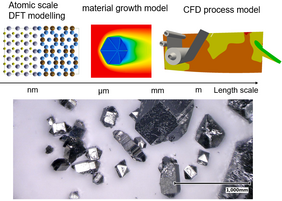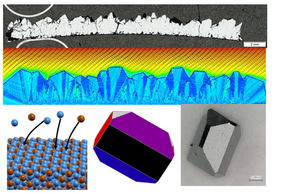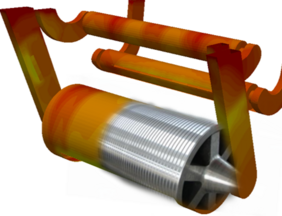Corrosion causes annual losses of up to approx. 3.4% of the global gross domestic product (GDP). The application of a suitable corrosion protection reduces costs and saves the environment. Many products are therefore protected against corrosion. For example, steel strips are coated with zinc-based corrosion protection layers to protect the products made from them, e.g. deep-drawn car body parts.
The continuous coating of steel strips in hot-dip galvanizing zinc baths is the main technology for corrosion protection of steel strips. Although widely used and long established, the hot-dip galvanizing process is confronted with new challenges regarding the coating quality and appearance. Novel coating alloys lead to unwanted chemical reactions in the
liquid zinc bath and on the bath equipment in the form of intermetallic dross particles, as shown in Fig.1. These particles cause surface defects of the coating on the steel strip and costly maintenance time in the production line.
In order to understand these phenomena and develop suitable solutions for the industry partners, multi-scale material and process models of the dross formation were designed. The main part for the practical analysis is the macroscale thermo-chemical fluid flow simulation which contains a virtual model of the zinc bath in the hot-dip galvanizing process. Operational process parameters are translated in this macroscale model to flow, temperature and concentration fields within the zinc bath. This information is coupled with developed thermodynamic and reaction-kinetic models to illustrate the local conditions in the zinc bath to the operators (see Fig.2).
The macroscale process model is linked to a microscale crystal growth model, which is able to describe the mass transfer between the liquid zinc and the crystal surface and to calculate the faceted growth of the dross particles. In order to acquire the model parameters atomic scale Density Functional Theory (DFT) modelling was conducted to predict the surface energies and the dross particle shape (see Fig.1).
Impact and effects
The results of the multi-scale material and process modelling will enable the industrial partners to better understand the hot dip galvanizing process and to derive optimized process parameters in order to reduce maintenance times and improve coating quality. High quality steel sheets can be sold at a price range up to 25% higher than steel sheets with standard surface quality. Current estimates show a potential added value to the industry due to improved coating quality of well over ~100 million dollars worldwide.
Project coordination (Story)
Dr. Georg Reiss
Key Researcher
Department Simulation
T +43 (0) 3842 45922–44
georg.reiss(at)mcl.at
Project partner
voestalpine Stahl Linz, Austria
International Zinc Association, USA
Montanuniversität Leoben, Chair of Thermoprocess Technology, Austria
Montanuniversität Leoben, Chair of Simulation and Modelling of Metallurgical Processes, Austria





















